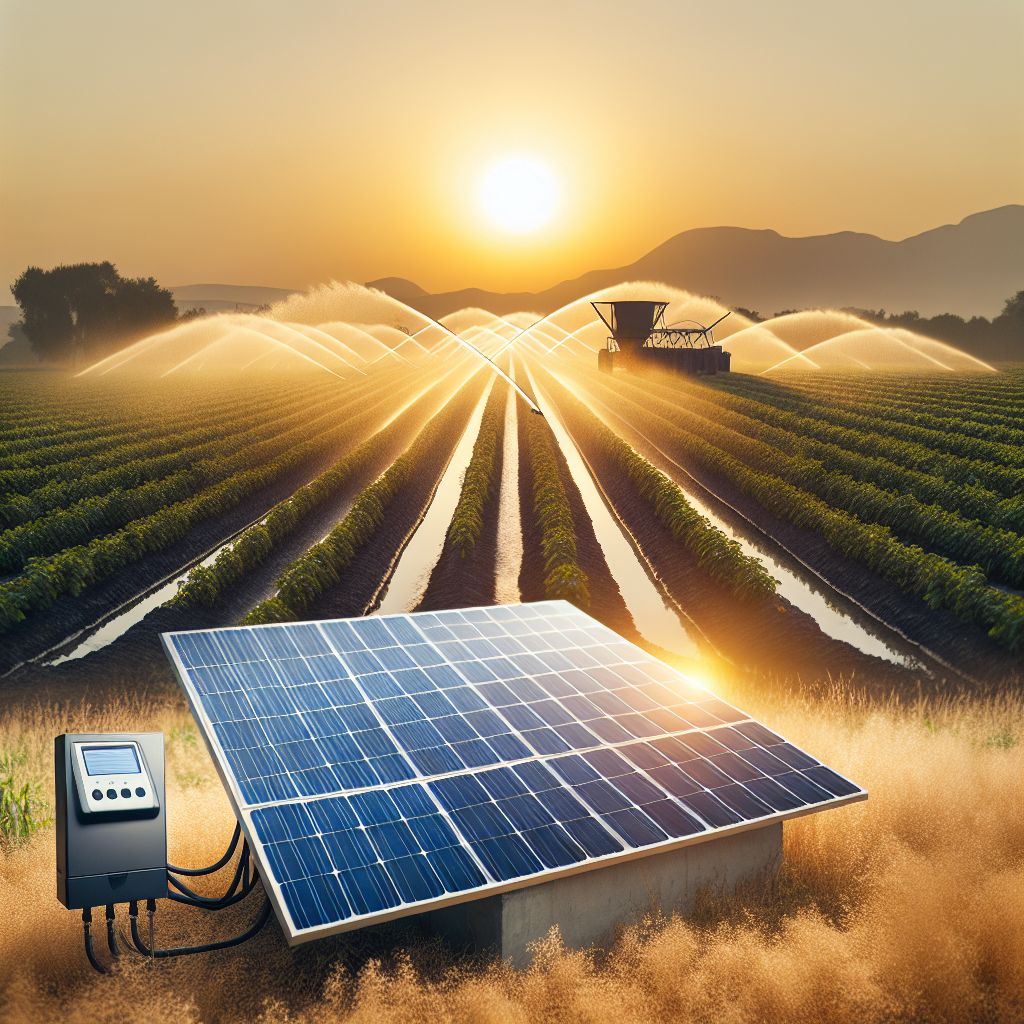
Key Takeaways
-
Monocrystalline solar panels are more efficient but also more expensive, ideal for limited space.
-
Polycrystalline solar panels are less costly and can be great for areas with abundant sunlight.
-
Choosing between monocrystalline and polycrystalline panels depends on budget, space, and energy needs.
-
Proper solar panel selection is crucial for the sustainability and efficiency of farm irrigation systems.
-
Both types of panels have their unique advantages and can contribute to a more sustainable agriculture system.
Choosing the Right Solar Panel for Farm Irrigation: Monocrystalline Solar Panels vs. Polycrystalline Solar Panel
When it comes to irrigating your farm sustainably, every drop of water and ray of sunlight counts. That’s why picking the right solar panel for your irrigation system is more than a matter of preference—it’s a crucial decision that affects your farm’s productivity and environmental footprint. In this guide, we’ll compare monocrystalline and polycrystalline solar panels to help you make the best choice for your farm.
Quick Overview of Monocrystalline Solar Panels and Polycrystalline Solar Panels
Before diving into the nitty-gritty, let’s clarify the basics. Monocrystalline solar panels are made from single-crystal silicon, making them highly efficient and recognizable by their uniform dark look. Polycrystalline solar panels, on the other hand, are made from multiple silicon crystals and appear slightly less uniform with a bluish hue. Efficiency, cost, and aesthetics are the main factors that differentiate them.
Importance of Solar Energy in Agriculture
Now, why even consider solar energy for farming? Well, solar energy is clean, renewable, and increasingly cost-effective. By harnessing the power of the sun for your irrigation needs, you’re not just cutting down on electricity bills; you’re also reducing your reliance on non-renewable energy sources. This move towards sustainability can not only save you money in the long run but also ensures that your farming practices are environmentally friendly.
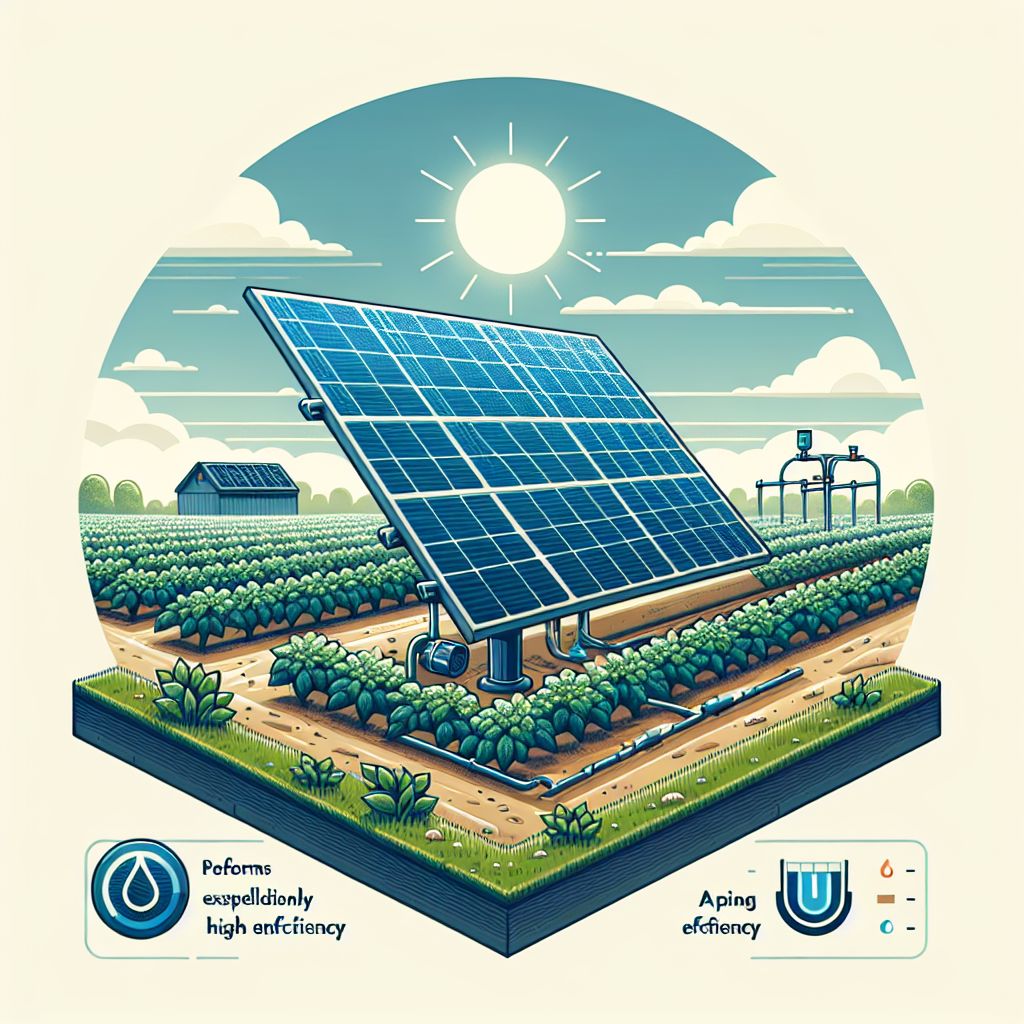
Understanding Monocrystalline Solar Panels
What Are Monocrystalline Panels?
Monocrystalline panels are the elder statesman of the solar panel world. They’ve been around the longest and boast high efficiency and power capacity. Because they’re made from a single, pure silicon crystal, they tend to perform better in low-light conditions and take up less space compared to polycrystalline panels. This makes them particularly useful when you’re working with a limited area.
Benefits for Using Monocrystalline Panels on Your Irrigation System
-
Higher efficiency rates mean you can generate more power per square foot.
-
Longer lifespan, typically around 25-30 years, ensures a good return on investment.
-
Better performance in low-light conditions, which is excellent for early mornings or cloudy days.
Monocrystalline panels are also aesthetically pleasing due to their uniform color, which might be a consideration if the appearance of your farm is important to you. But remember, they come with a higher price tag, so you’ll need to balance the initial investment against the long-term benefits.
Lifespan and Long-Term Performance
The durability of monocrystalline panels is one of their biggest selling points. They’re built to last, and most come with a warranty that guarantees their performance for decades. This long-term reliability means that, although you might pay more upfront, you’ll save more money over the lifespan of your solar panel system.
But don’t just take my word for it; the numbers speak for themselves. Studies have shown that monocrystalline panels retain a high percentage of their original efficiency even after 25 years of use. That’s a quarter of a century of reliable, renewable energy powering your irrigation system.

Understanding Monocrystalline Solar Panels
What Are Monocrystalline Panels?
Monocrystalline panels are the elder statesman of the solar panel world. They’ve been around the longest and boast high efficiency and power capacity. Because they’re made from a single, pure silicon crystal, they tend to perform better in low-light conditions and take up less space compared to polycrystalline panels. This makes them particularly useful when you’re working with a limited area.
Benefits for Using Monocrystalline Panels on Your Irrigation System
-
Higher efficiency rates mean you can generate more power per square foot.
-
Longer lifespan, typically around 25-30 years, ensures a good return on investment.
-
Better performance in low-light conditions, which is excellent for early mornings or cloudy days.
Monocrystalline panels are also aesthetically pleasing due to their uniform color, which might be a consideration if the appearance of your farm is important to you. But remember, they come with a higher price tag, so you’ll need to balance the initial investment against the long-term benefits.
This below table outlining some of the other benefits of both monocrystalline and polycrystalline solar panels:
| Benefit | Monocrystalline Solar Panels | Polycrystalline Solar Panels |
|---|---|---|
| Efficiency | Monocrystalline panels have higher efficiency due to their single silicon crystal structure. 2, 4 | Polycrystalline panels are slightly less efficient but offer a cost-effective solution. 2, 4 |
| Appearance | Monocrystalline panels have a darker appearance that blends well with most roofs. 5 | Polycrystalline panels have a bluer appearance. 5 |
| Cost | Monocrystalline panels are more expensive but provide higher efficiencies. 4 | Polycrystalline panels are more affordable, offering a cost-effective solution. 2, 4 |
| Space Efficiency | Monocrystalline panels are more space-efficient, ideal for limited roof space applications. 2, 4 | Polycrystalline panels are less space-efficient but can be a more economical option for larger installations. 2, 4 |
Lifespan and Long-Term Performance
The durability of monocrystalline panels is one of their biggest selling points. They’re built to last, and most come with a warranty that guarantees their performance for decades. This long-term reliability means that, although you might pay more upfront, you’ll save more money over the lifespan of your solar panel system.
But don’t just take my word for it; the numbers speak for themselves. Studies have shown that monocrystalline panels retain a high percentage of their original efficiency even after 25 years of use. That’s a quarter of a century of reliable, renewable energy powering your irrigation system.
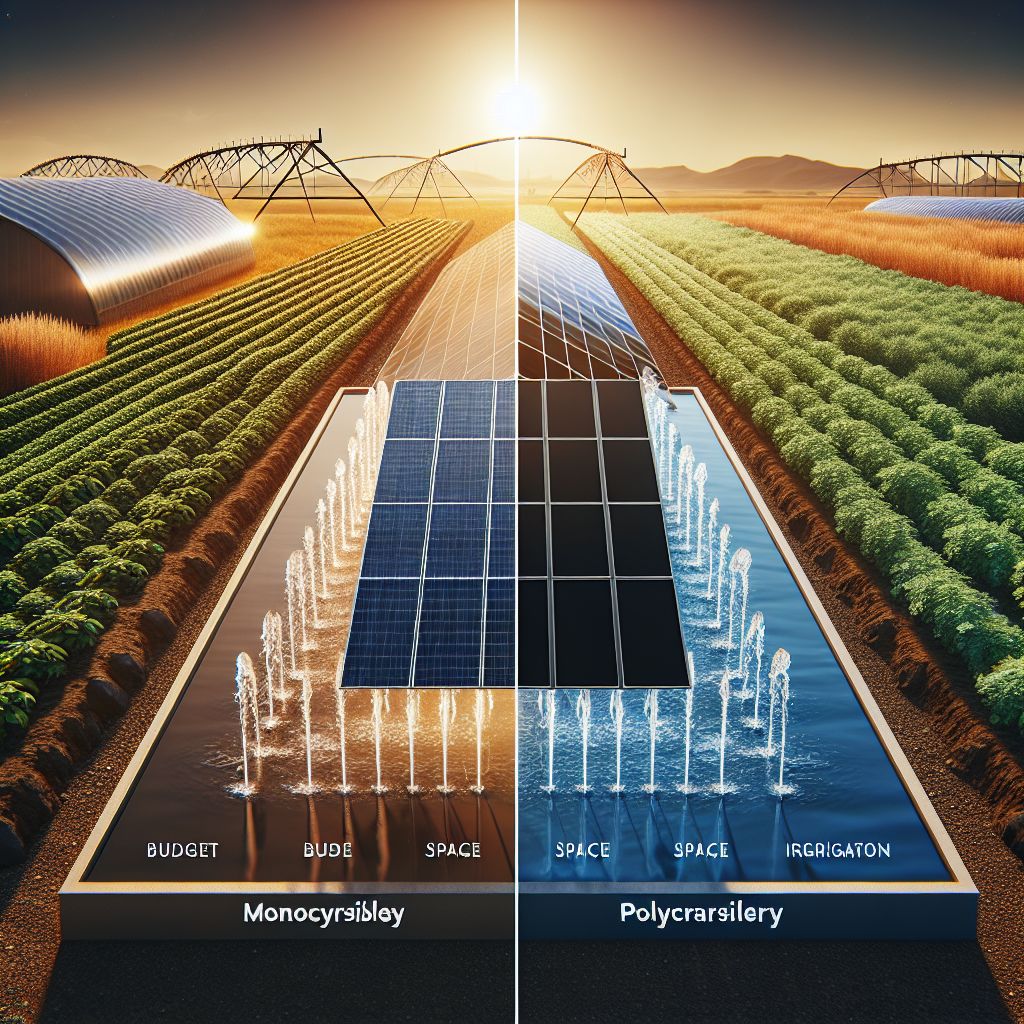
Monocrystalline or Polycrystalline: Making the Best Choice for Irrigation
Choosing between monocrystalline and polycrystalline solar panels boils down to your farm’s specific needs. Both types of panels have their pros and cons, and the best choice for your irrigation system will depend on a combination of factors including budget, space, and energy requirements.
This below table highlighting the main differences between monocrystalline and polycrystalline solar panels
| Feature | Monocrystalline | Polycrystalline |
|---|---|---|
| Manufacturing Process | Made from a single silicon crystal, more complex and wasteful. 2, 3, 4 | Made from multiple silicon fragments melted together, less wasteful. 2, 3, 4 |
| Appearance | Uniform black color with rounded edges. 1, 3, 5 | Blue hue with squared edges. 1, 3, 5 |
| Efficiency | Higher efficiency, typically 17-22%. 1, 2, 3, 5 | Lower efficiency, typically 15-17%. 1, 2, 3, 5 |
| Space Efficiency | More space-efficient due to higher efficiency. 1, 5 | Less space-efficient due to lower efficiency. 1, 5 |
| Performance in Heat | Better temperature coefficient, around -0.26% to -0.35% per °C. 1, 2, 3, 5 | Worse temperature coefficient, around -0.5% per °C. 1, 2, 3, 5 |
| Durability/Lifespan | 25 years or longer. 5 | 25 years or longer. 4, 5 |
Comparing Energy Output and Efficiency
Monocrystalline panels typically boast higher efficiency and output levels, which means they can generate more electricity from the same amount of sunlight. This is especially beneficial for smaller spaces or shaded areas. Polycrystalline panels, while slightly less efficient, can still be a viable option for farms with more space to install additional panels to meet their energy needs.
Assessing the Space Requirements and Flexibility
If you’re limited on space, monocrystalline panels are likely your best bet. Their higher efficiency means you’ll need fewer panels to meet your energy goals. However, if space isn’t an issue, polycrystalline panels can provide a more cost-effective solution, allowing you to cover a larger area without a significant increase in cost.
Understanding Impact on Farm’s Water Management
Ultimately, the type of solar panel you choose can significantly impact your farm’s water management system. Efficient solar panels ensure that your irrigation system gets the power it needs to operate optimally, which in turn helps you use water more responsibly and sustainably. This is critical for maintaining a farm that is not only productive but also environmentally conscious.
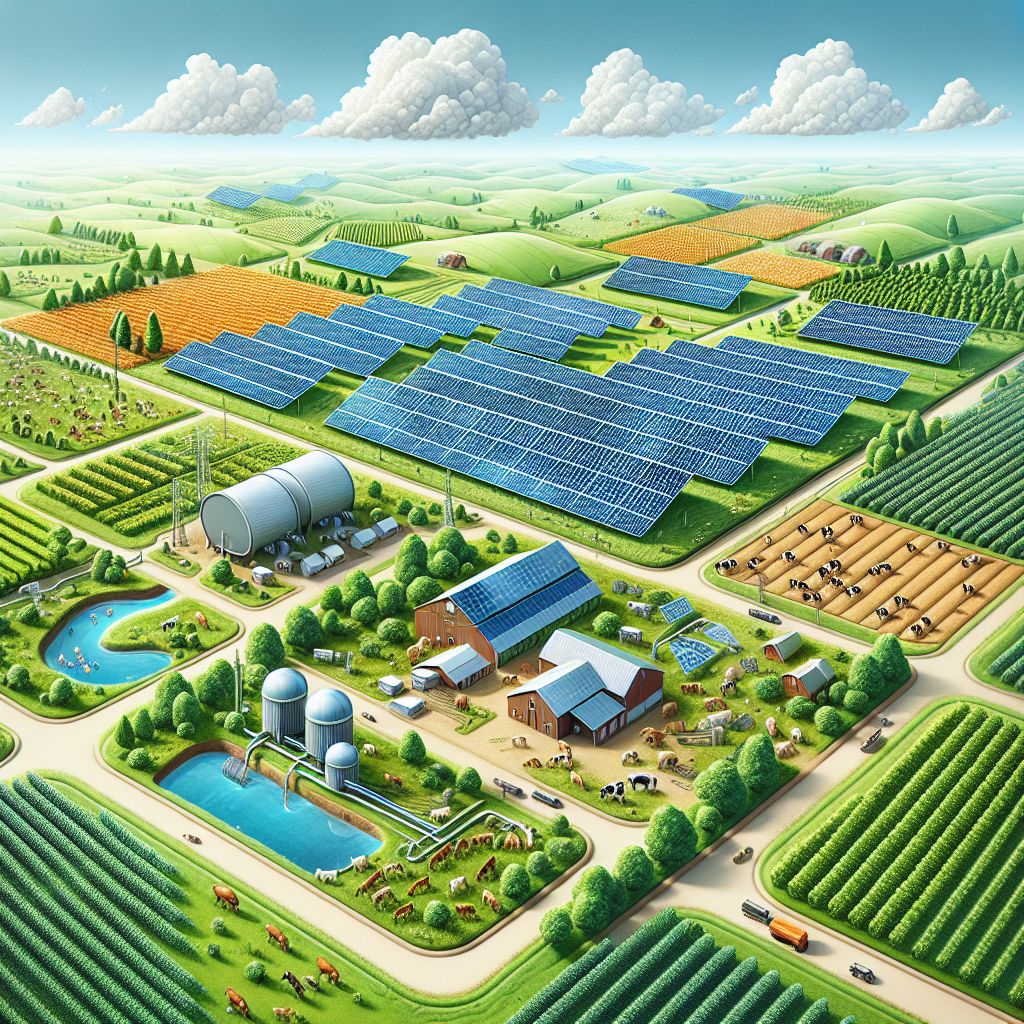
Real-World Applications on Farms
Let’s take a look at how these solar panels are actually used on farms. Real-world applications show that both monocrystalline and polycrystalline solar panels can be successfully integrated into farm operations to power irrigation systems and more.
Case Studies: Monocrystalline Panels in Action
A vineyard in California opted for monocrystalline panels to power their drip irrigation system. Despite limited space between rows, they were able to maximize energy production, resulting in a 20% reduction in water usage and a significant decrease in energy costs.
This example illustrates the advantage of using high-efficiency monocrystalline panels in space-constrained areas while also highlighting the potential for substantial water and cost savings.
Case Studies: Polycrystalline Panels Supporting Agriculture
In contrast, a large grain farm in the Midwest installed polycrystalline panels across an open field. The lower cost per panel allowed them to deploy a more extensive system, which offset the slightly lower efficiency and still met all their irrigation needs.
Such examples show that with careful planning, polycrystalline panels can be just as effective for farm irrigation, especially when space and budget considerations are taken into account.
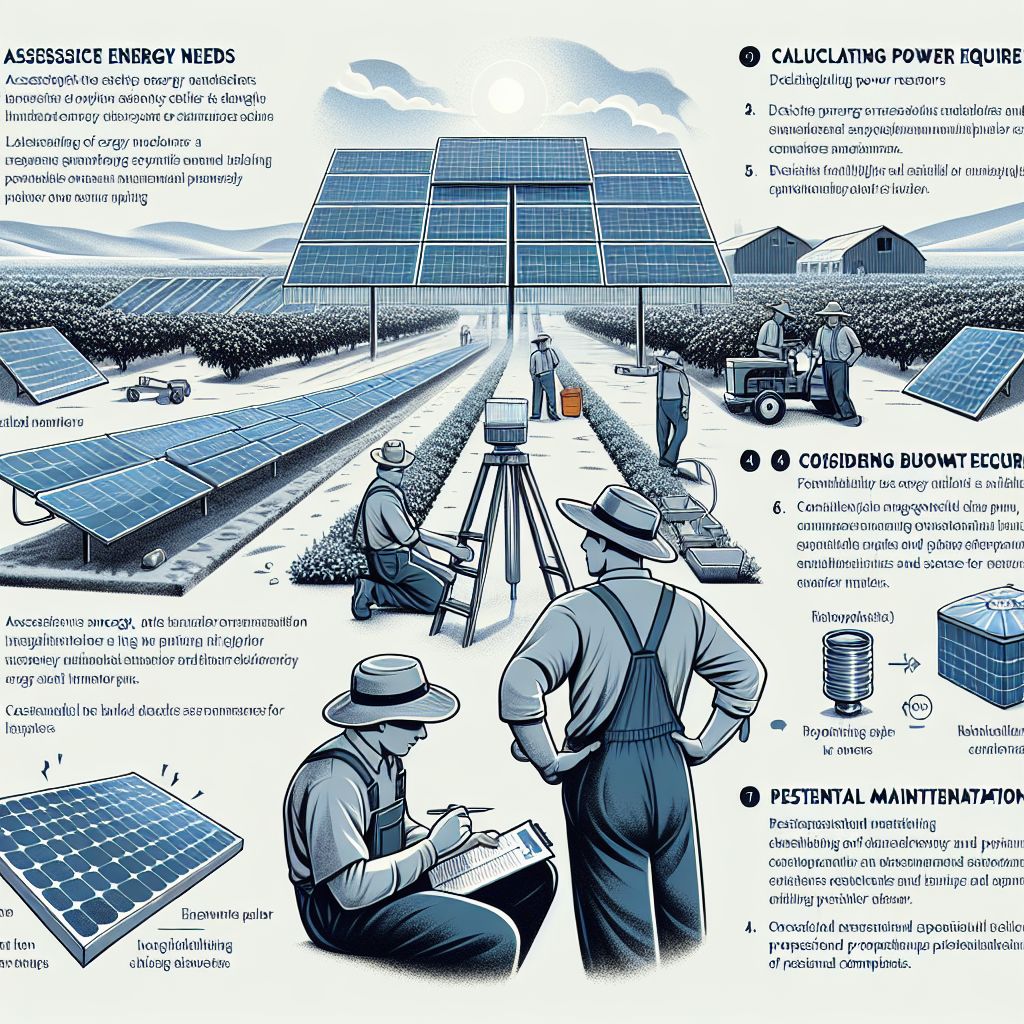
Installation Insights and Best Practices
Getting your solar irrigation system up and running requires careful consideration of several factors. Here are some insights and best practices to ensure that your installation goes smoothly and your system operates at peak efficiency.
Getting Started with Solar for Irrigation
First, assess your energy needs. Calculate the power requirements of your irrigation system and determine how many panels you’ll need. Next, consider your budget and the amount of space you have available for installation. With these factors in mind, you can decide whether monocrystalline or polycrystalline panels are more suitable for your farm.
Once you’ve made your choice, it’s crucial to work with a reputable solar installer who has experience with agricultural systems. They can provide valuable guidance on the best placement for your panels to ensure maximum sunlight exposure and energy production.
Maintenance is also key to the longevity of your solar panels. Regular cleaning and inspections will help keep them functioning efficiently and can prevent potential issues before they become costly problems.
Maintenance Tips to Maximize Panel Life
Maintaining your solar panels is crucial to ensure they last as long as possible and continue to operate efficiently. Regular cleaning to remove dust, debris, and bird droppings will help maintain their performance. It’s also wise to check for any shading that may have developed over time, such as from growing trees, as this can significantly impact the energy output. Moreover, have a professional conduct periodic checks to ensure the electrical components are functioning correctly and safely.
FAQs
When deciding to invest in solar panels for farm irrigation, several questions may arise. Here are some of the most frequently asked questions and their answers to help you navigate your solar journey.
Understanding these FAQs will arm you with the knowledge needed to make informed decisions and maximize the benefits of solar energy for your farm’s irrigation needs.
How Do I Calculate the Number of Solar Panels Needed for My Irrigation System?
To calculate the number of solar panels needed for your irrigation system, first determine the total wattage of your pumps and other components. Then, factor in the number of hours they operate each day. With this information, you can estimate the daily energy consumption of your system. Next, consider the average peak sunlight hours in your location to determine how much energy your panels can produce. Dividing your daily energy requirement by the expected daily energy production per panel will give you an estimate of the number of panels you need.
Can I Use a Mix of Monocrystalline and Polycrystalline Panels?
Yes, you can use a mix of monocrystalline and polycrystalline panels in your solar array. This might be a practical solution if you want to balance cost with efficiency or if you have varying space constraints. However, it’s essential to ensure that the electrical characteristics of the panels are compatible, and it’s often recommended to use the same type of inverter for the entire system.
What Incentives are Available for Sustainable Farming Practices?
Many regions offer incentives for sustainable farming practices, including the installation of solar panels. These can range from tax credits and rebates to grants and subsidized loans. It’s important to research the incentives available in your area, as they can significantly offset the initial cost of solar panel installation.
For instance, in the United States, the federal government provides a tax credit for solar energy systems, and many states have additional incentives. Always check with local authorities or energy advisors to understand the incentives you qualify for.
How Does Panel Choice Affect the Overall Cost of Solar Installation?
The choice between monocrystalline and polycrystalline panels can significantly affect the overall cost of your solar installation. Monocrystalline panels are more expensive but also more efficient, which means you may need fewer of them. Polycrystalline panels are less expensive, but you might need more to achieve the same energy output. When calculating the cost, consider not only the price per panel but also the total number of panels needed, installation costs, and potential long-term savings on energy bills.
What Other Considerations Should I Take into Account When Choosing Solar Panels for Irrigation?
Besides cost and efficiency, there are several other considerations to keep in mind when choosing solar panels for irrigation. These include the climate of your area, the reliability and warranty of the panels, the expertise and track record of the installation company, and the potential for future expansion of your solar system. It’s also worth considering the environmental impact of the panel production process and the end-of-life recycling options.
Conclusion: Which Solar Panels are Best for an Irrigation System
In conclusion, the choice between monocrystalline and polycrystalline solar panels for an irrigation system on a farm boils down to your specific circumstances. Monocrystalline panels are more efficient and space-saving but come with a higher initial cost. Polycrystalline panels are more budget-friendly and can be just as effective in the right conditions. Ultimately, the best solar panels for your irrigation system are the ones that meet your energy needs, fit your budget, and contribute to the sustainability of your agricultural practices.
Remember, investing in solar energy for irrigation is not only about immediate benefits but also about securing a sustainable and cost-effective future for your farm. With the right planning and consideration, solar panels can be a valuable addition to your farm’s infrastructure, ensuring that you have a reliable water supply for years to come.






